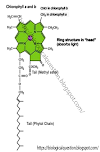Mitochondria
Mitochondria (singular: mitochondrion) are present in all eukaryotic cells. Some cells have a single large
mitochondrion, but more often a cell has hundreds or even thousands of mitochondria; the number
correlates with the cell's level of metabolic activity. For example, cells that move or contract have
proportionally more mitochondria per volume than less active cells. Mitochondria are capable to divide
themselves (self-replicating) in order to increase their number. They divide by fission.
External Structure of Mitochondria :
Mitochondria are cylindrical or rod shaped structures. They are enclosed by double membrane, the
outer membrane and the inner membrane. The outer membrane is smooth and somewhat like a sieve
due to presence of porins. These are special proteins responsible for the transport of molecules across
the membrane. Porins allow free passage of various molecules into the Inter-membrane space.
Internal Structure of Mitochondria :
The inner membrane is
selectively permeable and folded inwards. The folds are called cristae which serve to increase the surface
area. The inner surface of cristae has granular structures called F0-F1 particles. These particles are
actually ATP synthase (see section 4.2.7) enzymes. In addition, several other complexes are also found in
inner mitochondrial membrane, which serve as electron carriers in electron transport chain. The inner
membrane divides the mitochondrion into two internal compartments. The first is the intermembrane
space, the narrow region between the inner and outer membranes. The second compartment, the
mitochondrial matrix, is enclosed by the inner membrane. Mitochondrial matrix is a jelly like material
that contains a small circular DNA, all kinds of RNA, ribosomes (70S) and enzymes. The presence of these
components indicates that mitochondria have their own genetic system. It means, the protein, which are
required by mitochondria are synthesized by their own metabolic machinery.
Diagram Mitochondria Structure
Function of Mitochondria :
Mitochondria are the sites of cellular respiration, the metabolic process that uses oxygen to generate
ATP by extracting energy from sugars, fats, and other organic compounds. Enzymes in the matrix catalyze
some of the steps of cellular respiration like Krebs cycle. Other proteins that function in ATP generation
through electron transport chain are found into the inner membrane.
Thankyou for Reading the article.



.png)

.png)
0 Comments